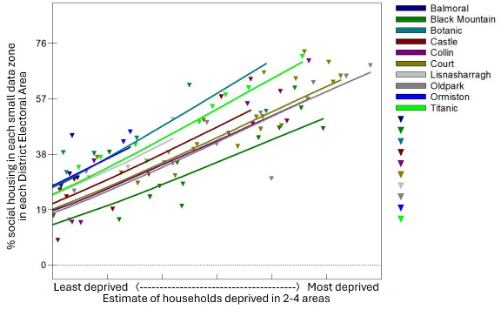
Policy Watch
An eye on policy changes in Ireland, the UK and beyond
Part Four: What can the census data tell us about social housing provision and deprivation in Belfast?
Part Four in PPR’s new policy series ‘A new look at housing: what the census data can tell us about social housing provision and deprivation’
A quick look at Belfast might incorrectly note that, taken as a whole, it would seem to have towards the higher end of social housing provision relative to deprivation, therefore it should not be prioritised in terms of social housing provision. In reality, sub-areas with low deprivation show high levels of social housing investment, skewing the district average; while in more deprived areas, levels of social housing do not rise to meet need.
So far our analysis of census data has taken in Northern Ireland as a whole. However, it’s also worth looking in more detail at individual areas such as Belfast.
In Belfast, we see that there is real variation in levels of deprivation across smaller geographical areas.
The graph below (figure 11) shows that almost 5 in 10 households in the Court area of Belfast are deprived on two or more measures (eg education and health), compared with 2 in 10 in Balmoral, Lisnasharragh and Ormiston. Broadly speaking the most deprived areas are in the north and west of the city and the least deprived areas are in the south and east. Figure 12 shows the location of these DEAs geographically.

Figure 11: The % of deprived households in each Belfast District Electoral Area

Figure 12: A map of District Electoral Areas in Belfast. The map also includes the Wards within each Area. The small data zones created by NISRA do not overlap with Ward boundaries. This is why we have used District Electoral Areas and Local Government Districts in the analysis in these blogs.
As with Northern Ireland more generally, variation is also found around household tenure:

Figure 13: Tenure differences across DEAs in Belfast
Just as we did for Northern Ireland in part 3 of this blog series, we have compared levels of deprivation and social housing provision for the District Electoral Areas in Belfast. Figure 14 shows the ‘lines of best fit’ for each Belfast DEA, and the variability.
In each DEA, see Figure 14, there is a positive relationship between deprivation and social housing provision: as deprivation increases, the provision of social housing increases. However, there are two additional points that speak to the key issue of whether social housing provision in Belfast is in proportion to need. It’ll be easier to spot these if we zoom in on the high deprivation side of the graph, (note, Balmoral is tucked underneath Ormiston).
Point 1: while areas of lower deprivation have similar, and comparably low levels of social housing provision, the rate at which social housing becomes available, in the more deprived parts of DEAs, differs. In Balmoral, Botanic, Ormiston, Lisnasharragh and Titanic, social housing provision increases more steeply, as deprivation increases. In Castle, Collin, Court, and Oldpark, the increase is not as steep. In Blackmountain, the increase in social housing provision, as deprivation increases, is at its most shallow. Clearly, some Belfast areas have much higher levels of social housing investment relative to deprivation than others. Black Mountain, despite having high levels of deprivation, has comparatively lower levels of social housing provision than Titanic or Ormiston.


Figure 14: The relationship between deprivation and both actual (the triangles) and estimated (making up the lines of best fit) social housing provision in Belfast District Electoral Areas.
Point 2: Because of the differential relationship between deprivation and housing provision, the reality is that South and East Belfast have higher proportions of social housing, despite comparatively lower levels of deprivation. North and West Belfast have lower proportions, and the area around the Mackie’s site, see Figure 15, where the Take Back the City coalition is campaigning for more social homes, has almost the lowest of all, see Figure 16.

Figure 15: The small data zones that cover the Mackies site, and its immediate surroundings, in red, other small data zones with Court District Electoral Area are in black.

Figure 16: The relationship between deprivation and both actual (the triangles) and estimated (making up the lines of best fit) social housing provision in Belfast District Electoral Areas – now separating between Court 1 and Court 2, with Court 2 including those small data zones that cover the Mackies site and its immediate surroundings.
Where should policy makers target their investment?
It would of course be nonsensical to talk about reducing social housing units in some areas to bring them in line with the average; rather what would be needed would be to raise provision in areas of lower investment to the same level. In this way, using South Belfast as a template, we can figure out how many more social homes would be needed in more deprived areas of Belfast to match its level of social housing investment.
When South Belfast is set as the benchmark for social housing provision relative to deprivation, the area around Mackie’s can be shown to have a deficit of around 386 social homes. This is only a measure of the number needed if we are making provision equitably using South Belfast as our yardstick, and bearing in mind that census definitions of deprivation are themselves limited. The whole of West Belfast by the same token, would need 1595 homes. On this analysis, East Belfast requires fewer homes because it already has a relatively more generous provision of social housing according to its deprivation levels.

Table 2: Number of social homes required in areas of Belfast to bring them up to similar levels of investment as South Belfast.
The number of homes needed for each area, in Table 2, is the take home message. Just as technical detail, remember how the triangles in our (SDZs/DEAs) graphs, did not overlap perfectly with the lines of best fit? This is because there is a substantial amount of variability in PRS provision that is unrelated to the measure of deprivation used here. To calculate, then, how different social housing provision is in each area relative to South Belfast, we needed to subtract the proportion of unaccounted for homes from the South Belfast proportion, and then multiply the corrected proportion by the number of social homes in each area. This then gave an estimate of the number of social homes each area was short, relative to South Belfast, due to a baseline difference in the experience of deprivation.

Table 3: Social housing provision unaccounted for through the limited measure of objective need/deprivation used here.
However, it must be remembered that deprivation is not the only marker against which to measure social housing provision – factors like preference also clearly matter, and more social homes should be built in areas of high demand. The impact of tenants’ purchase of their social homes under the House Sales Scheme has also not been factored in; it is possible that before the advent of the scheme, provision more closely matched objective need. However as it stands, it is clear that levels of social housing provision currently do not correspond to measures of objective need – including in the area around the Mackie’s site.
